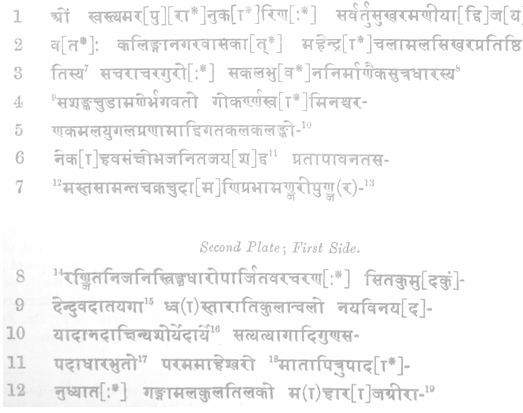|
The Indian Analyst
|
North Indian Inscriptions |
ALAMANDA PLATES OF ANANTAVARMAN. ......The inscription records the gift of the village of Mede[lâ]ka in the Tirikaṭu-vishaya (line 13 f.) to a Brâhmaṇa of the Vâjasanêya school (l. 16). The grant was made at Kaliṅgânagara1 (l. 2) on the day of a solar eclipse (l. 18) in “the three-hundred-and-fourth year of the reign of the G[â]ṅgêya race” (l. 28 f.). The donor was king Anantavarman, the son of the Mahârâja Râjêndravarman, a member of the Gaṅga family (l. 12 f.) and a worshipper of Mahêśvara (l. 11). The wording of the passage which celebrates the virtues of the king (ll. 1 to 12), is identical with that of the corresponding passage in a copper-plate grant of Dêvêndravarman, the son of the Mahârâja Anantavarman.2 As Dr. Fleet has expressed his intention of treating the chronology of the Gaṅgas of Kaliṅga,3 I refrain from attempting any conjectures regarding the date of the new inscription, and would only point out that it appears to refer to the same era as the grant of the year 254,4 and that, consequently, the king Anantavarman, by whom the subjoined grant was issued, appears to be distinct from, and later than, another Anantavarman, who was the father of Dêvêndravarman.
TEXT.5
......1 This is probably the modern “Calingapatam ;” Ind. Ant. Vol. XVIII. p. 144, Mr. Sewell’s Lists of
Antiquities, Vol. I. p. 7.
| ||||||||||||||||||||||||||||||||||||||||||||||||||||||||||||||||||||||||||||
| > |
|
>
|









